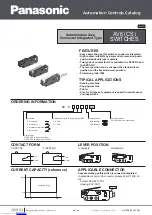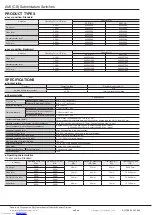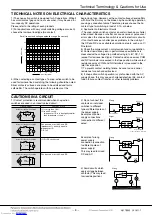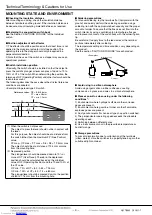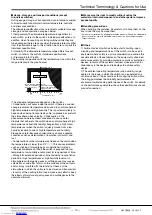
Technical Terminology & Cautions for Use
AECTB36E 201811-T
OPERATING CHARACTERISTIC
TECHNICAL NOTES ON MECHANICAL CHARACTERISTICS
■
Definition of operating characteristic
The main terminological illustrations and
meanings which are used with snap-
action switches are as follows.
Center of mounting holes
FP
OF
RF
TT
MD
OT
TTP
OP
PT
TF
RP
Classification
Terminology
Symbol
Unit
Varying
display
method
Starting current
Force
Operating
Force
OF
N
Max.
The force required to cause contact snap-action. It
is expressed terms of force applied to the the
actuator.
Release
Force
RF
N
Min.
The force to be applied to the the actuator at the
moment contact snaps back from operated
position to total travel position.
Totaltravel
Force
TF
N
Force applied to an actuator required to move from
an operating position to a total travel position
Movement
Pretravel
PT
mm,
degree
Max.
Distance or agree of the actuator movement from
free position to operating position.
Overtravel
OT
mm,
degree
Min.
The distance or degree which the actuator is
permitted to travel after actuation without any
damage to the switching mechanism.
Movement
Differential
MD
mm,
degree
Max.
The distance or degree from operating position to
release position of the actuator.
Totaltravel
TT
mm,
degree
The migration length or the move angle from the
free position to total travel position of actuator
Position
Free
Position
FP
mm,
degree
Position of the actuator when no force is applied
to.
Operating
Position
OP
mm,
degree
±
The position of the actuator when the traveling
contacts snaps with the fixed contact.
Release
Position
RP
mm,
degree
The position of the actuator when the traveling
contact snaps back from operating position to its
original position.
Total travel
Position
TTP
mm,
degree
The stopping position of the actuator after total
travel.
■
Actuation Force and Stroke
Adequate stroke setting is the key to high reliability. It is also
important that adequate contact force be ’maintained to ensure
high reliability. For a normally closed (NC) circuit, the driving
mechanism should be set so that the actuator is normally in the
free position. For a normally open (NO) circuit, the actuator
should be pressed to 70% to 100% of the specified stroke to
absorb possible errors.
If the stroke is set too close to the operating point (OP), this may
cause unstable contact, and in the worst case may cause
actuator damage due to inertia of the drive mechanism. It is
advisable that the stroke be adjusted with the mounting plate or
driving mechanism.
The figure at right
shows a typical
example of activation
and contact forces
varying with stroke.
In the vicinity of the
OP and RP, the
contact force is
diminished, causing
chatter and contact
bounce immediately
before or after
reversal. For this
reason, use the
switch while giving
due consideration to
this. This also causes
the snap action
switch to be sensitive
to vibration or shock.
■
Changes in Operating Characteristics
Exercise design care so that malfunctions will not occur if the
operating characteristics vary by as much as 20% from, rated
values.
<Example>
In the OF max. 0.98N specification for FS snap-action switches,
the allowable max. is 0.98 N
×
(100%+20%) = 1.18 N
In the RF min. 0.15 N min. specification
the allowable min. 0.15 N
×
(100%–20%) = 0.12 N
■
Mechanical Conditions for Type Selection
Actuator type should be selected according to activation
method, activation speed, activation rate, and activation
frequency.
1) An extremely slow activation speed may cause unstable
contact transfer, possibly resulting in contact failures or contact
fusion.
2) An extremely high activation speed may cause damage to
contacts or contact response failure.
■
Driving Mechanism
Use of a driving mechanism which will cause physical impact to
the actuator should be avoided.
<Example>
Bad
Good
OF
RF
PT
NC
On FP
On reversal
On reversal
On OTP
NO
Stroke
Stroke
MD
OT
FP
RP
OP
TTP
Contact force
Operating force
ー 7 ー
Downloaded from
Downloaded from
Downloaded from
Downloaded from
Downloaded from
Downloaded from
Downloaded from

